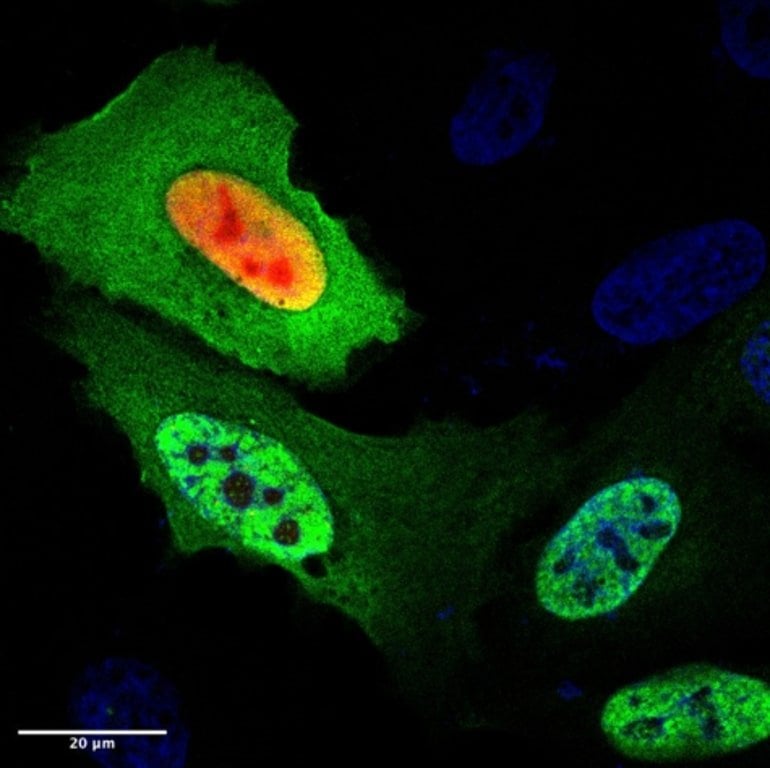Summary: Restoring levels of the DAXX protein prevents misfolding of proteins that drive Alzheimer’s disease and other neurodegenerative diseases.
Source: University of Pennsylvania
For the first time, Penn Medicine researchers showed how restoring levels of the protein DAXX and a large group of similar proteins prevents the misfolding of the rogue proteins known to drive Alzheimer’s and other neurodegenerative diseases, as well as certain mutations that contribute to cancers. The findings could lead to new targeted approaches that would restore a biological system designed to keep key proteins in check and prevent diseases.
The findings were published online in Nature.
The study focuses on DAXX, or death domain-associated protein, which is a member of a large family of human proteins, each with an unusually high content of two specific amino acid residues, aspartate and glutamate, referred to as polyD/E proteins. The various roles of DAXX and approximately 50 other polyD/E proteins in cell processes have emerged over time, but their role as a protein quality control system — a “chaperone” that directs protein folding, so to speak — was unanticipated.
“We solve a decades-long puzzle by showing this group of proteins actually constitute a major protein quality control system in cells and a never-before-seen enabler of proper folding of various proteins — including misfolding-prone proteins associated with various diseases,” said senior author Xiaolu Yang, PhD, a professor of Cancer Biology in the Perelman School of Medicine at the University of Pennsylvania.
“Keep that family of proteins functioning properly, and the tangling of rogue proteins may be diminished or stopped altogether.”
Proteins are the workhorses of the cell. To ensure normal cellular function and protect against protein-misfolding associated with disease, organisms have evolved elaborate protein quality control systems to enable efficient protein folding. However, these systems, especially those in humans, are still not well understood, which limits the ability to develop effective therapies.
The researchers showed that DAXX and other polyD/E proteins facilitate the folding of proteins, reverse protein aggregates, and unfold misfolded proteins. They prevent neurodegeneration-associated proteins, such as beta-amyloid and alpha-synuclein from misfolding, tangling, and forming extracellular plaques and intracellular inclusions, they found.
Beta-amyloid clumping between the nerve cells is observed in the brains of Alzheimer’s disease patients and the target of many treatment approaches, while intracellular inclusions of alpha-synuclein are observed in the brains of patients with Parkinson’s disease.

The team also showed DAXX’s potential role in treating cancer.
DAXX restores native function to tumor-associated and aggregation-prone p53 proteins, reducing their cancer properties. That’s important because p53 is the preeminent tumor suppressor and mutations in p53 are associated with a bevy of cancers, including lung, colon, pancreatic, ovarian, and breast cancer. Bolstering DAXX function, the authors said, might represent an alternative approach to therapeutically reestablish the tumor suppressive function of mutant p53 to treat patients.
“The findings give us a better understanding of a new biochemical activity that effectively contends with protein misfolding seen in Alzheimer’s and other neurodegenerative diseases, as well as in cancer, and represent an opportunity to develop new approaches to treat these diseases,” Yang said.
The first author of the study is Liangqian Huang, PhD, a postdoctoral researcher in Yang’s lab.
Funding: This work was supported by National Institutes of Health (R01CA182675, R01CA184867, R01CA235760, R01CA243520, P01 AG031862, and R01GM099836), an Alzheimer’s Association Research Fellowship, a Warren Alpert Foundation Distinguished Scholars Fellowship, and a Sponsored Research Agreement from Wealth Strategy Holding Limited.
About this Alzheimer’s disease research news
Author: Caren Begun
Source: University of Pennsylvania
Contact: Caren Begun – University of Pennsylvania
Image: The image is credited to the researchers
Original Research: Closed access.
“DAXX represents a new type of protein-folding enabler” by Liangqian Huang, Trisha Agrawal, Guixin Zhu, Sixiang Yu, Liming Tao, JiaBei Lin, Ronen Marmorstein, James Shorter & Xiaolu Yang. Nature
Abstract
DAXX represents a new type of protein-folding enabler
Protein quality control systems are crucial for cellular function and organismal health. At present, most known protein quality control systems are multicomponent machineries that operate via ATP-regulated interactions with non-native proteins to prevent aggregation and promote folding, and few systems that can broadly enable protein folding by a different mechanism have been identified. Moreover, proteins that contain the extensively charged poly-Asp/Glu (polyD/E) region are common in eukaryotic proteomes, but their biochemical activities remain undefined.
Here we show that DAXX, a polyD/E protein that has been implicated in diverse cellular processes, possesses several protein-folding activities. DAXX prevents aggregation, solubilizes pre-existing aggregates and unfolds misfolded species of model substrates and neurodegeneration-associated proteins.
Notably, DAXX effectively prevents and reverses aggregation of its in vivo-validated client proteins, the tumour suppressor p53 and its principal antagonist MDM2. DAXX can also restore native conformation and function to tumour-associated, aggregation-prone p53 mutants, reducing their oncogenic properties. These DAXX activities are ATP-independent and instead rely on the polyD/E region. Other polyD/E proteins, including ANP32A and SET, can also function as stand-alone, ATP-independent molecular chaperones, disaggregases and unfoldases.
Thus, polyD/E proteins probably constitute a multifunctional protein quality control system that operates via a distinctive mechanism.







